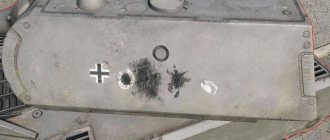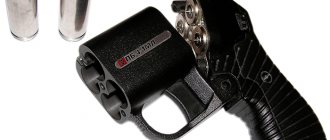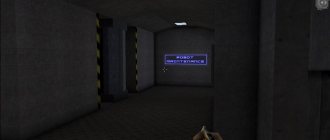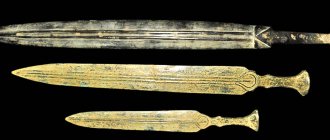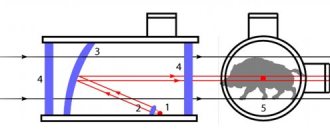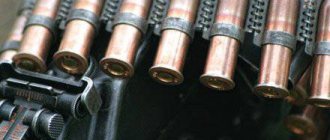At the beginning of the 16th century, France, and then other European countries, were gripped by “dueling fever,” which raged on the continent for more than three centuries. In just a few decades of the reign of the French king Henry IV, duels led to the death of approximately ten thousand people, most of whom belonged to the noble class. The main weapon in duels of that time was the sword.
Sword. This word itself is shrouded in a romantic aura. Pronouncing it, it’s as if you are transported to the narrow streets of Paris or Seville into the world of arrogant and hot-tempered hidalgos and musketeers, so masterfully described in the brilliant books of Dumas and Arturo Perez-Reverte. Without a doubt, the sword is the most “noble” edged weapon, the defender of noble honor and the most faithful friend of the brethren.
It is believed that the sword appeared around the middle of the 15th century in Spain. Very quickly it became popular not only in the army, but also as a civilian weapon for nobles or simply wealthy people. Over time, the sword turned into an indispensable attribute of any man from the noble class, and fencing with swords became the favorite pastime of the nobles. It is not without reason that in various European countries (including Russia) there was a custom of the so-called civil execution, during which the condemned man’s sword was broken over his head.
It was the sword that made a huge contribution to the development of fencing. Since dueling with swords was common, men learned to use these weapons from a young age. Fencing lessons were common, taken by men of all ages. In Europe there was even a very specific institution - fencing fraternities. These associations of professional fencers had an extensive network of branches, experienced instructors and a special examination system.
Today, epee fencing is an Olympic sport, although it must be recognized that sports epee combat is very different from the fencing matches of the past. The same can be said about the design of a sports sword, which has little in common with the blades of musketeers.
The rapier is considered a further development of the sword. Translated from Spanish, espada ropera literally means "dress sword", that is, a weapon carried with a civilian suit. In other words, the rapier was an exclusively civilian weapon, intended primarily for stabbing. Sort of like a light version of a sword. In Russia, a rapier is often called a weapon with a faceted blade, intended for training matches. However, the main difference between a sword and a rapier is that the latter has never been a military weapon.
It must be said that there is a lot of confusion on this issue. In historical sources, the same weapon can be called both a sword and a rapier. A similar situation is also observed in popular literature (for example, in “The Three Musketeers”). Of course, the most common opinion is that a sword was a weapon that could be used to chop an enemy, and a rapier could only be used to inflict injections. But, probably, contemporaries did not go into such subtleties too much, so initially these names were synonyms, which subsequently led to noticeable confusion.
History of weapons
At the end of the Middle Ages, instead of heavy brutal swords, elegant light rapiers and swords began to be used more and more often. In essence, they were the same weapon, only with a narrower blade and a complex guard. Both models have gone through a long history of development and acquired special characteristics.
A sword is a heavy piercing type of weapon, consisting of a blade and a handle. It appeared at the stage of the spread of firearms across Europe against the background of the gradual abandonment of heavy chain mail and armor. The models first came into use in Spain, where they gained popularity by the 1460s.
Swords were actively used in cavalry and infantry regiments until the beginning of the 18th century, then they were replaced by the saber and broadsword. There were two types of bladed weapons: civilian and army. The first option was lighter in weight and was sharpened only at the tip of the tip, while the second was used by warriors.
The rapier, unlike the sword, historically was a lightweight version of the weapon. It first appeared in Spain towards the end of the 15th century. Initially used as a ceremonial sword, it was decorated with precious stones. A little later, a combat version appeared, complemented by a special guard that protected the hand.
Literally, “rapier” translates as “sword for wearing with clothes.”
The rapier reached its maximum distribution in the 16th–17th centuries. Throughout this period, weapons were subject to changes and improvements, according to the fashion trends of the time. In addition, fencing made its own adjustments and the emergence of new requirements.
Since the 18th century, the rapier has been greatly replaced by light short swords. In France, faceted models were used, in Italy - shortened by about a third. Such weapons were characterized by lighter weight, so it was much more convenient to fencing with them.
The first Spanish swords were called espadas roperas. The word espadas means “sword”, and “roperas” means “rapier”; many researchers are inclined to believe that they were originally synonyms
Swords were used in cavalry and infantry regiments until the beginning of the 18th century
The jeweled rapier was originally an alternative to the ceremonial sword
Fencing
The appearance of the sword gave a powerful impetus to the development of fencing. It cannot be said that before this they used swords to cut as best they could, but it was the lightness of the sword that made it possible to significantly expand the arsenal of fencing techniques. Very quickly, recognized fencing schools appeared: Italian, Spanish, French, German. Each of them had its own characteristics.
The Germans, for example, paid a lot of attention to slashing blows, and as an auxiliary weapon they used a heavy pistol, the handle of which struck like a club.
In the Italian school of fencing, for the first time, they emphasized piercing blows with the tip. It was in Italy that the principle of “killing with the point, not the blade” was born. A special dagger, the daga, was often used as an additional weapon in a fight. By the way, it is believed that duels appeared in Italy, replacing medieval knightly tournaments and duels.
The French school of fencing gave birth to a light short sword and gave the world the basic techniques for handling it. It is this that underlies modern sports fencing.
In England, during fights they often used a special shield-knuckles or daga.
The Spanish school of fencing was called Destreza, which can be translated as “true art” or “skill.” It taught not only how to fight with swords, but also how to use items such as a cloak, a daga, and a small shield in battle. The Spaniards paid attention not only to the skills of handling weapons, but also to the moral development of the fighter and the philosophical aspects of the art of war.
Is the sport of fencing that exists today similar to real sword fighting? There is an interesting statement that if a modern master of sports fencing went back in time, he could easily cope with any sword master of the Renaissance. Is it so?
The most important technical technique of modern athletes is the lunge attack, which is almost completely absent in ancient Italian and Spanish fencing schools. However, would it be useful in a real fight?
A lunge attack forces the fencer to stretch his stance. In this position, he is static, and it is difficult for him to defend against enemy attacks. In sports fencing, after the injection is carried out, the match is stopped, which, of course, is impossible in a real fight. At the same time, a single injection absolutely does not guarantee victory over the enemy. In sports fencing there are practically no defenses; fights are held according to the principle “whoever hits first gets the point.” In a real fight, it is simply necessary to defend yourself, because a missed injection does not mean the loss of a point, but injury, or even death.
Moreover, in the arsenal of historical fencing schools there were not only defenses with the blade, but also body movements: sharp rebounds, departures from the line of attack, sudden changes in level. In modern fencing, moving away from the line of attack is completely prohibited.
Now let's look at the weapons used by modern athletes and compare them with the swords of old times. A modern sports sword is a flexible steel rod weighing 700-750 grams; the main task of this weapon in battle is to lightly touch the opponent’s body. The swords of the old masters could weigh up to 1.5 kg; with this weapon it was possible not only to stab, but also to chop, depriving the enemy, for example, of his hands.
Even the fencing stances described in ancient manuals are the opposite of modern ones.
There is another myth, it is associated with the contrast between European and Eastern fencing techniques. They say that the Japanese are real virtuosos in the use of edged weapons, and the Europeans defeated their rivals in fights only due to physical strength and endurance.
This is not entirely true. The development of Japanese fencing can be divided into two large stages: before the onset of the Edo era and after it. The early periods of the history of the Land of the Rising Sun are remembered for almost continuous internecine wars, in which warriors fought on the battlefield using long tati swords and heavy armor. The fencing technique was very simple and consistent with that used in medieval Europe.
After the onset of the Edo era, the situation changed dramatically. Heavy armor and long swords are abandoned. The katana becomes a new mass weapon, which leads to the emergence of a new fencing technique, complex and sophisticated. Here we can draw direct analogies with Europe, where similar processes took place: the heavy combat sword was replaced by the sword. It was the appearance of these weapons that led to the emergence of very complex fencing schools, such as the Spanish Destreza, for example. Judging by the written sources that have come down to us, European fencing systems were not much inferior to Eastern ones. Although, of course, they had their own characteristics.
Rapier Features
The rapier is a bladed weapon of the piercing type. Strikes to the enemy are inflicted only with the tip. The design weighs 500 g and has an elastic blade with a tetrahedral cross-section. The length of the blade is 90–110 cm, the round guard has a diameter of 12 cm and serves to protect the hand from damage. The maximum size of the entire structure reaches 110 cm.
Fencing models are equipped with a fixed tip, which is located on the edge of the blade. In electrified models, this element is represented by a special movable device with a button. When injecting an opponent, this component is pressed, resulting in the electrical circuit being closed.
There is a special notch on one of the edges of the electrified rapier blade. It runs along the entire surface of the blade all the way to the handle. A wire is fixed in the groove, which connects the electrical contact tip and the connector located under the guard.
Unlike a sword, the straight handle of a rapier is sometimes replaced with a figured one, located perpendicular to the blade. Inside such elements there is a nut that secures the hilt. It is necessary to ensure that the wrist does not bend when holding the handle. This option is called a “pistol”; it is usually installed on electrified models.
The process of creating high-quality blades is a real art. When producing steel, it is important to maintain the exact ratio of iron and carbon. Otherwise, the blade will be brittle and short-lived. Any model, including the rapier, is created using gradual layering of metal.
The first layer consists of iron, which reliably holds its shape and gives the product the necessary strength. The second is made from steel, which increases elasticity. In the process of making weapons, both of these materials were never used separately from each other.
Why did the sword replace the sword?
Sword
It was designed in such a way as to penetrate the weakest points of armor - the joints and seams in armor and chain mail.
The sword
appeared as a result of long-term modifications of the classic
sword
, subsequently completely replacing it.
The name comes from the Italian – “spada”, which means “ sword
”.
Interesting materials:
When can you contribute maternity capital to a mortgage? When can you get up after a myocardial infarction? When can meat be introduced into complementary foods? When can you drive into oncoming traffic? When can I get out on parole? When can you take your puppy outside? When can I take a donor day? When can you take out a loan according to the lunar calendar? When can you take a vacation followed by dismissal? When can you take leave from the army?
Sword parameters
A sword is a heavy piercing weapon, similar in design to a rapier. However, the length of the product will be slightly longer, the weight is 770 g. The blade has a triangular cross-section and increased rigidity. The hand is protected from damage by a round guard, the diameter of which reaches 13.5 cm.
Sword fighting involves striking all parts of the opponent's body except the back of the head. In fencing there is no priority of actions. A blow delivered more than 0.25 seconds later than the previous one is not counted.
Injections made by opponents simultaneously are mutually recorded and awarded to both athletes.
Each sports model has a guard. This element is classified according to the degree of closure of the hand. There are several types:
- "Spanish" bowl. Deep version with a pair of rings inside. During the battle, the sword is held by them or by the hilt itself.
- Bilbo. The most secure model, unlike the previous version. It has an additional bow and a larger bowl.
- Papenheimer. It is a developed guard with a cup and hand protection. It looks like a complex interweaving of arches.
- Flemish guard. It is made in the form of a crosshair with rings or shields, and does not have a bow.
- Cavalry. It is complemented by arches that cover the hand.
After the military sword passed into the rank of court decoration and ceremonial weapon, the hilts began to be decorated with precious stones; their weaving was a real work of art. Along with this, the crosshair has almost completely disappeared. In sports, the tip of the sword is equipped with a special sensor that responds to pressure over 550 grams.
Comparative characteristics
Swords and rapiers have a rich history of development and have not lost their relevance today. The differences between these two weapons are as follows:
| Characteristics | Swords | Rapiers |
| Weight, g | From 770 | 500 |
| Length, cm | 110 | From 90 |
| Blade section | Triangular | tetrahedral |
| Guard diameter, cm | 13,5 | 12 |
| Tip | Equipped with a special sensor that triggers when pressure exceeds 550 g | Equipped with a movable electrical contact sensor |
| Injection | Apply to any part of the body, with the exception of the back of the head | Apply only to the jacket |
| Priority of actions | No | Eat |
Rapiers differ in that the straight handle can be replaced with a figured version.
There really is a difference between swords and rapiers, although outwardly these types of bladed weapons are very similar. The design of the models has undergone major changes more than once. Improved versions have survived to this day, which are actively used in the art of fencing.
Rapier and sword differ in the length and width of the blade
Rapier sometimes allows you to replace a straight handle with a figured one
The most common modern point of view is that the sword is a bladed weapon that allows you to both stab and chop the enemy, and the rapier can only stab
Combat saber
Having considered the differences between a rapier and a sword, attention should be paid to weapons such as a saber.
This is one of the most ancient weapons. Due to its characteristics, modern techniques of sports combat have also been formed.
The saber is a cutting weapon. Its blade has a curved shape. With the help of a saber it is also possible to deliver a piercing blow. For this purpose, the tip was well sharpened by the warriors before the upcoming battle.
The presented type of weapon appeared in the eastern territories. Such products became widespread back in the 7th-8th centuries. With its help, chopping and piercing wounds were inflicted. Over time, the design has changed. By the 14th century, it was already an exclusively chopping blade, characterized by significant curvature. The weight was relatively light. The center of gravity was shifted away from the hilt. This made it possible to strike with greater force.


